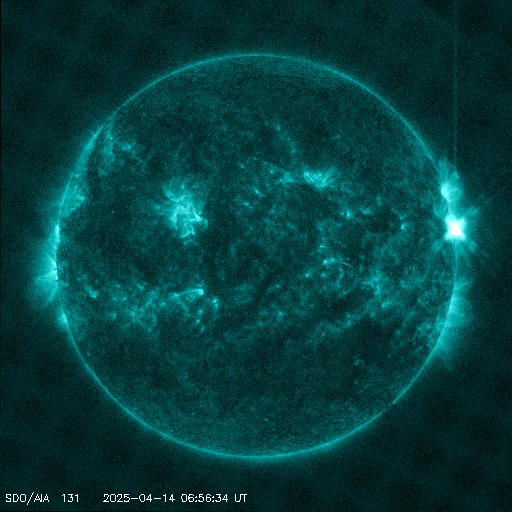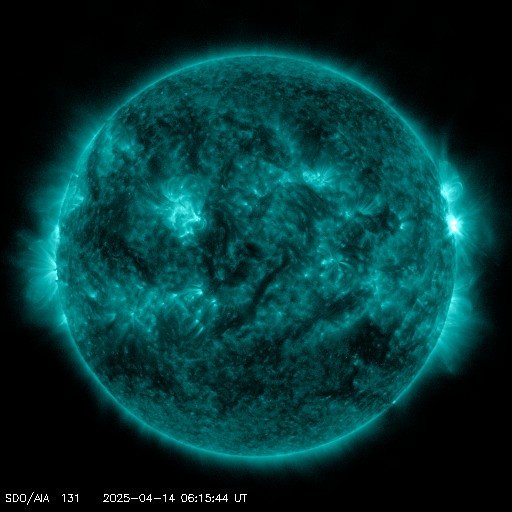Viewing archive of Tuesday, 8 September 2020
Daily bulletin on solar and geomagnetic activity from the SIDC
Issued: 2020 Sep 08 1230 UTC
SIDC Forecast
Solar flares
Quiet conditions (<50% probability of C-class flares)
Geomagnetism
Quiet (A<20 and K<4)
Solar protons
Quiet
| 10cm flux | Ap | |
|---|---|---|
| 08 Sep 2020 | 070 | 003 |
| 09 Sep 2020 | 070 | 003 |
| 10 Sep 2020 | 070 | 003 |
Bulletin
The Sun was spotless. Solar activity was at very low levels and is expected to remain so.
The greater than 10 MeV proton flux was at nominal levels. The greater than 2 MeV electron flux reached high levels, with a maximum of 10200 pfu at 16:00UT. The 24h electron fluence was at moderate levels. There's a chance that the electron flux and 24h fluence reach high levels during the next 24 hours.
No earth-directed coronal mass ejections (CMEs) were observed in available coronagraphic imagery. A slow CME (186 km/s) first observed by LASCO/C2 on 7 September at 21:24UT seemed to have its source at or just beyond the west limb and has apparently no earth-directed component.
Solar wind speed was on a declining trend, from about 370 km/s initially to 315 km/s at the end of the period (DSCOVR). Bz was steady between -3 and +3 nT. The interplanetary magnetic field (phi angle) was predominantly directed away from the Sun (positive sector).
Geomagnetic activity was at quiet levels and is expected to remain so.
Today's estimated international sunspot number (ISN): 000, based on 18 stations.Solar indices for 07 Sep 2020
| Wolf number Catania | /// |
| 10cm solar flux | 070 |
| AK Chambon La Forêt | 006 |
| AK Wingst | 004 |
| Estimated Ap | 003 |
| Estimated international sunspot number | 000 - Based on 28 stations |
Noticeable events summary
| Day | Begin | Max | End | Loc | Strength | OP | 10cm | Catania/NOAA | Radio burst types | |
|---|---|---|---|---|---|---|---|---|---|---|
| None | ||||||||||
Provided by the Solar Influences Data analysis Center© - SIDC - Processed by SpaceWeatherLive
All times in UTC
Current data suggests there is a slight possibility for aurora to appear at the following high latitude regions in the near future
Edmonton, AB, Gillam, MB, Saskatoon, SK, Whitehorse, YT, Yellowknife, NTAnchorage, AK, Fairbanks, AK, Juneau, AK
Latest news
Latest forum messages
Support SpaceWeatherLive.com!
A lot of people come to SpaceWeatherLive to follow the Sun's activity or if there is aurora to be seen, but with more traffic comes higher server costs. Consider a donation if you enjoy SpaceWeatherLive so we can keep the website online!

Latest alerts
07:09 UTC - Solar flare
Moderate M4.28 flare from sunspot region 4055
06:48 UTC - Radio Blackout
Minor R1 radio blackout in progress (≥M1 - current: M1.53)
06:24 UTC - Solar flare
Moderate M1.49 flare from sunspot region 4055
06:06 UTC - Radio Blackout
Minor R1 radio blackout in progress (≥M1 - current: M1.16)
04:45 UTC - Geomagnetic activity
Active geomagnetic conditions (Kp4) Threshold Reached: 04:29 UTC
Space weather facts
| Last X-flare | 2025/03/28 | X1.1 |
| Last M-flare | 2025/04/14 | M1.4 |
| Last geomagnetic storm | 2025/04/06 | Kp5 (G1) |
| Spotless days | |
|---|---|
| Last spotless day | 2022/06/08 |
| Monthly mean Sunspot Number | |
|---|---|
| March 2025 | 134.2 -20.4 |
| April 2025 | 132.1 -2.1 |
| Last 30 days | 132.4 -10.7 |





